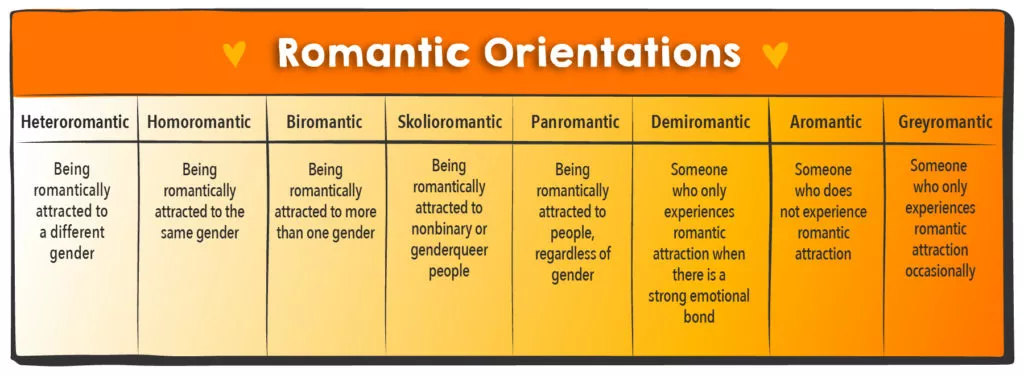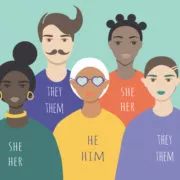Our sexual orientation is who we are attracted to physically, and our romantic orientation is who we are attracted to emotionally. Some people are sexually and romantically attracted to the same types of people, while for others these two orientations are different. Everybody experiences this spectrum a bit differently. With some people it seems to be an absolutely obvious distinction, and with others it’s not. There are gray areas along this spectrum and definitions are changing over time. It is a good idea for some to think about orientation as a universe of possibilities versus a spectrum or binary.
What is Sexual Attraction?
A desire to have sexual contact with someone. This may or may not involve romantic feelings for someone. It’s possible to have sexual feelings for someone you don’t have romantic feelings for.
What is Romantic Attraction?
A deep desire to have a committed, romantic relationship with someone. This may or may not involve sex. It’s possible to be romantically interested in someone but not be sexually attracted to them. A person may feel warm butterflies when they are around someone, frequently want to be with them, or be a part of their life. A person may feel a deep emotional connection to someone and may want to be physically affectionate with them.
What about Friendships?
Friendships can involve deep emotional connections and intimacy — with or without romantic or sexual feelings.
Some friendships may involve romantic attraction; for example if two friends write love letters to each other.
Some friendships may involve sexual tension or attraction; for example, friends who also engage in intimate or sexual activities with each other, commonly known as, “friends with benefits.”
A platonic relationship means that the friendship may have a close bond but may not share intimate or sexual feelings in any way.
How Sexual Orientation & Romantic Orientation Differ
What someone looks for in a sexual partner is not always the same as what they look for in a romantic partner, this includes gender. Someone who is sexually attracted to more than one gender (such as someone who is bisexual or pansexual) might only be able to see themselves in a romantic relationship with someone of the same gender (homoromantic).
A person might be physically attracted to or sexually intimate with someone who they’re not romantically attracted to or “in love with.” At the same time, they may have loving and romantic attractions to people who they are not physically attracted to.
Different Types of Sexual Orientations
Different Types of Romantic Orientations
Can a Person’s Sexual and Romantic Orientation be different?
Yes! Someone might identify with one sexual or romantic orientation, or several. For example, a person who identifies as biromantic and asexual can be romantically attracted to multiple genders, and is not sexually attracted to anyone. Biromantic asexuals seek romantic, but not sexual, relationships with people of different gender identities.
Another person might identify as heteroromantic and demisexual, meaning that they seek romantic relationships with people of a different gender, and they only experience sexual attraction when there is a strong emotional bond.
Some people notice their orientation changes over time, while for others it stays the same for their whole life. No matter whether it’s very important to a person, or if they have never thought about it, sexual and romantic orientation is just one part of who they are.
What determines someones Sexual or Romantic Orientation?
While it is not known what causes someone to be bisexual, lesbian, straight, or gay, what is known is that all sexual and romantic orientations are healthy and normal ways to be. Many people begin to have sexual and romantic thoughts during puberty, and it’s completely normal to have these about people of any gender.
Some people know their orientation very clearly: for example, a girl who always liked girls and identifies as lesbian. For others, it can take several years to understand their sexual orientation.
Many people go through a period of questioning who they are attracted to, even if they don’t tell anyone about it. Some people use the label “questioning” while they are unsure about their orientation, still exploring, or if they are concerned about applying a label to themselves.
Sexual and romantic orientation is not something a person chooses, and not something that can be changed by pressure from family or friends, therapy, or treatments. Just as a gay person cannot be “turned” straight, a straight person can’t be “turned” gay.









